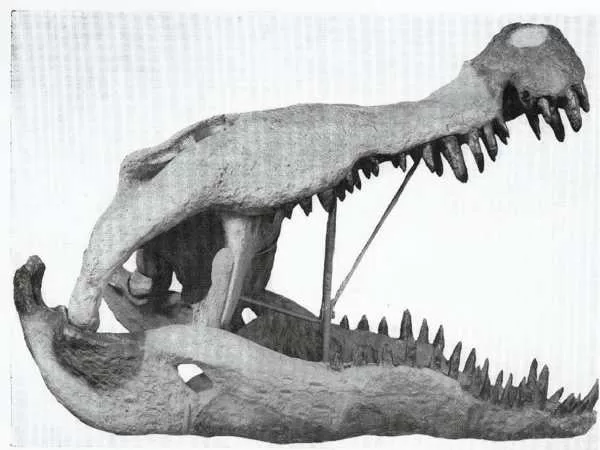Around 79 million years ago, the shores of what is now Georgia were home to an enormous reptile that ruled the waterways with an iron jaw. Known as Deinosuchus, this prehistoric beast, stretching up to 29 feet (nearly 9 meters) long, prowled the coastal waters, much like today’s crocodiles and alligators. Recent research reveals that this giant predator likely feasted on both sea turtles and dinosaurs, providing a fascinating glimpse into its diet and behavior.
Deinosuchus: A Crocodilian Colossus
Deinosuchus, though not a true crocodile, belonged to the same crocodilian group and shared a closer relation to modern alligators than to crocodiles. The name Deinosuchus means “terrible crocodile,” and its formidable size and diet certainly live up to that description. Researchers suggest that Deinosuchus was a dominant force in its environment, consuming prey that ranged from sea turtles to dinosaurs.
David Schwimmer, a paleontologist at Columbus State University, led recent studies uncovering new insights into the diet of this colossal reptile. Schwimmer and his student, Samantha Harrell, analyzed various fossil specimens, including dinosaur bones, sea turtle remains, and the teeth of Deinosuchus itself. Their findings paint a vivid picture of this ancient predator’s feeding habits.
Evidence of a Diverse Diet
The research team’s analysis of Deinosuchus teeth revealed significant wear and tear. The tips of its teeth were often broken, a sign that the reptile frequently consumed hard substances like bones. Schwimmer explained, “These teeth were thick and blunt, built like little hub caps, especially the back teeth.” This dental structure suggests that Deinosuchus was well-equipped to handle tough prey, including both sea turtles and dinosaurs.
Among the most compelling evidence of Deinosuchus’s predatory behavior are the bite marks found on dinosaur bones. Schwimmer and his team identified distinctive marks on various dinosaur fossils, including tailbones from duck-billed dinosaurs discovered in the western United States. They also examined the leg bone of a small carnivorous dinosaur, currently housed in a New Jersey museum. Schwimmer described the damage to the leg bone, saying it looked “like a chew toy, like a dog had been working on it.” These bones were covered with crocodilian bite marks, further confirming Deinosuchus’s role as a fearsome predator.
Similar bite marks were also observed on turtle shells, indicating that sea turtles were a significant part of Deinosuchus’s diet. The combination of these findings paints a picture of a versatile predator that thrived in its aquatic environment.
Poop Tells the Tale
Further supporting these conclusions, the research team examined fossilized feces, or coprolites, discovered along Hannahatchee Creek in Stewart County, Georgia. These coprolites, each about half a foot long (15 centimeters) and 2 to 3 inches (5 to 7.6 centimeters) in diameter, match the expected size of excrement from such a large reptile.
Analysis of the coprolites revealed no bones, which aligns with the fact that crocodilian digestive acids are strong enough to dissolve bones. Instead, the feces contained sand and numerous shell fragments, providing clues about the diet and habitat of Deinosuchus. The presence of shell fragments suggests that Deinosuchus often consumed sea turtles and lived in a shallow, warm-water environment, possibly near a river mouth where sea turtles were abundant.
Habitat and Behavior
The findings offer insight into the lifestyle of Deinosuchus. The large crocodilian likely inhabited riverine environments with access to both freshwater and saltwater. The warm, shallow waters would have been ideal for both hunting sea turtles and scouring the landscape for other prey, including dinosaurs.
Deinosuchus’s predatory prowess, combined with its massive size, would have made it a top predator in its ecosystem. The evidence from bite marks, dental wear, and coprolites provides a clearer picture of how this ancient reptile interacted with its environment and prey.
Legacy of Deinosuchus
The discovery of Deinosuchus’s dietary habits adds to our understanding of prehistoric ecosystems and the interactions between different species. By studying the remains and traces of these ancient creatures, scientists can reconstruct the food webs and behaviors that shaped their world.
Deinosuchus stands as a testament to the diverse and formidable life forms that once roamed Earth. Its ability to prey on both sea turtles and dinosaurs highlights the adaptability and ferocity of ancient crocodilians. The research not only enriches our knowledge of these ancient predators but also deepens our appreciation for the complexity of past ecosystems.
As paleontologists continue to unearth and analyze fossils, we gain further insight into the lives of these prehistoric giants. Deinosuchus, with its immense size and varied diet, remains a fascinating subject of study and a symbol of the ancient world’s extraordinary biodiversity.

